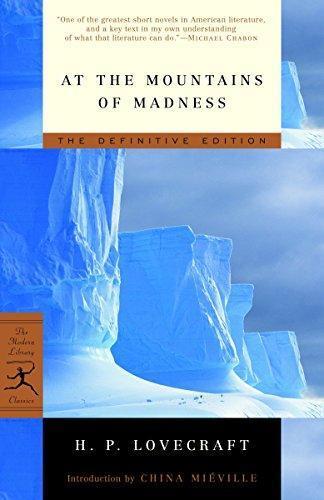Cossiol reseñó At the Mountains of Madness de H.P. Lovecraft
None
5 estrellas
absolutament demencial

194 páginas
Idioma English
Publicado el 16 de diciembre de 2005
At the Mountains of Madness is a science fiction-horror novella by American author H. P. Lovecraft, written in February/March 1931 and rejected that year by Weird Tales editor Farnsworth Wright on the grounds of its length. It was originally serialized in the February, March, and April 1936 issues of Astounding Stories. It has been reproduced in numerous collections. The story details the events of a disastrous expedition to Antarctica in September 1930, and what is found there by a group of explorers led by the narrator, Dr. William Dyer of Miskatonic University. Throughout the story, Dyer details a series of previously untold events in the hope of deterring another group of explorers who wish to return to the continent. These events include the discovery of an ancient civilization older than the human race, and realization of Earth's past told through various sculptures and murals. The story was inspired by Lovecraft's …
At the Mountains of Madness is a science fiction-horror novella by American author H. P. Lovecraft, written in February/March 1931 and rejected that year by Weird Tales editor Farnsworth Wright on the grounds of its length. It was originally serialized in the February, March, and April 1936 issues of Astounding Stories. It has been reproduced in numerous collections. The story details the events of a disastrous expedition to Antarctica in September 1930, and what is found there by a group of explorers led by the narrator, Dr. William Dyer of Miskatonic University. Throughout the story, Dyer details a series of previously untold events in the hope of deterring another group of explorers who wish to return to the continent. These events include the discovery of an ancient civilization older than the human race, and realization of Earth's past told through various sculptures and murals. The story was inspired by Lovecraft's interest in Antarctic exploration; the continent was still not fully explored in the 1930s. Lovecraft explicitly draws from Edgar Allan Poe's novel The Narrative of Arthur Gordon Pym of Nantucket, and he may have used other stories for inspiration. Many story elements, such as the formless "shoggoth," recur in other Lovecraft works. The story has been adapted and used for graphic novels, video games, and musical works.
absolutament demencial
Perhaps I had too high expectations. But then again, it's H. P. Lovecraft. I'd say his work is generally hyped a lot. This was my first encounter with his opus and it was decidedly meh.
I guess my main issue is that simply restating that a thing is terrible and scary over and over again does not make it scary. Majority of descriptions are second hand in so far as they describe the impact of events, setting, etc. on the main protagonist (i.e. he perceived them as scary), and not the inherent quality of themselves. Even the description of this second hand impact is somehow sterile.
The novella is written as a quasiscientific report from an old school research expedition. Perhaps that is what influenced the sterile delivery. Then again, I contrast this with Eversion by Alastair Reynolds which came out recently, adopts a similar style (and to …
Perhaps I had too high expectations. But then again, it's H. P. Lovecraft. I'd say his work is generally hyped a lot. This was my first encounter with his opus and it was decidedly meh.
I guess my main issue is that simply restating that a thing is terrible and scary over and over again does not make it scary. Majority of descriptions are second hand in so far as they describe the impact of events, setting, etc. on the main protagonist (i.e. he perceived them as scary), and not the inherent quality of themselves. Even the description of this second hand impact is somehow sterile.
The novella is written as a quasiscientific report from an old school research expedition. Perhaps that is what influenced the sterile delivery. Then again, I contrast this with Eversion by Alastair Reynolds which came out recently, adopts a similar style (and to a point theme), and yet manages to delivers far more compelling storytelling. Of course, it is also a much newer book. But if I am to judge Lovecraft as the master of the genre I can't really disregard this issue on the grounds of relative age of his works.
One thing I liked was the feeling of a larger prevailing mythos loosely connecting this and other Lovecraft's works. It gave the world a richer texture. But, for now at least, I guess I won't be exploring this world any further.